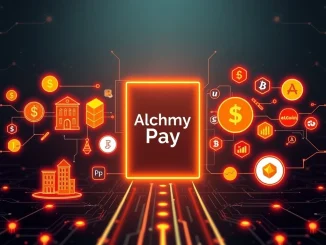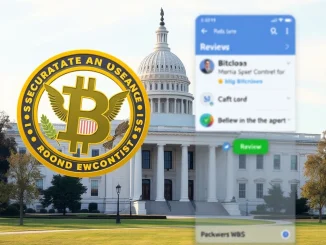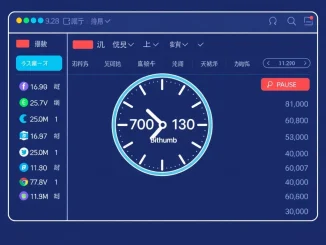
In a significant nod to the evolving landscape of global finance, the CEO of Goldman Sachs, David Solomon, has spotlighted **tokenization** as a transformative force, particularly within the realm of financing. This isn’t just another tech buzzword; it’s a powerful acknowledgment from one of the world’s leading investment banks, signaling a profound shift in how assets might be created, traded, and managed in the very near future. For anyone tracking the intersection of traditional finance and emerging digital innovations, this statement from **Goldman Sachs** carries immense weight, hinting at a future where digital assets play a central role in our economic infrastructure.
Tokenization: A Game-Changer for Finance
So, what exactly is **tokenization**, and why is it drawing such high-level attention from institutions like Goldman Sachs? At its core, tokenization is the process of converting rights to an asset into a digital token on a blockchain. Think of it as digitizing ownership or access to anything from real estate and art to private equity and bonds. This isn’t just about creating a digital representation; it’s about embedding the asset’s rules, ownership, and transferability directly into a secure, transparent, and immutable ledger – the blockchain.
For the world of financing, the implications are vast. Tokenization promises to:
Enhance Liquidity: By breaking down large, illiquid assets (like a skyscraper or a private fund) into smaller, tradable tokens, it becomes easier for investors to buy and sell fractional ownership, increasing market accessibility and liquidity.
Improve Efficiency: Automated processes through smart contracts can reduce the need for intermediaries, streamline transactions, and cut down on settlement times and costs.
Increase Transparency: All transactions are recorded on a public or permissioned ledger, providing an auditable trail and reducing fraud.
Democratize Access: Lower entry barriers mean a wider range of investors, including retail participants, can access previously exclusive investment opportunities.
Imagine a future where investing in a fraction of a commercial building or a high-yield corporate bond is as simple as buying shares in a publicly traded company. That’s the promise **tokenization** brings to the table.
Goldman Sachs’s Vision: Embracing Digital Assets
Goldman Sachs has a complex history with cryptocurrencies and blockchain. While often perceived as cautious, the institution has consistently explored the underlying **blockchain technology** and its potential beyond speculative digital currencies. David Solomon’s remarks are a clear indication that the firm sees practical, revenue-generating applications for this technology, especially in structured finance.
Goldman Sachs has already been quietly experimenting with various aspects of digital assets. They’ve been involved in:
Digital Asset Offerings: Exploring tokenized bonds and other securities.
Blockchain-based Platforms: Developing proprietary platforms for digital asset trading and custody.
Strategic Investments: Investing in companies that are building the infrastructure for the digital asset ecosystem.
Solomon’s focus on financing suggests that the bank is looking at how tokenization can optimize their core business operations, from capital markets to asset management. It’s about making existing processes faster, cheaper, and more accessible, rather than just dabbling in new, unproven markets. This strategic embrace of **digital assets** underscores a growing conviction within the traditional finance sector that this technology is here to stay and will fundamentally alter how financial instruments are created and managed.
How Blockchain Technology Powers Tokenized Financing
The backbone of **tokenization** is **blockchain technology**. Without it, the benefits of immutable records, transparency, and automated execution via smart contracts wouldn’t be possible. Blockchain provides the secure, distributed ledger necessary to record and verify ownership of tokenized assets.
Here’s a simplified look at how blockchain enables tokenized financing:
Asset Digitization: A real-world asset (e.g., a bond) is digitized, and its details are recorded on a blockchain. This creates a unique digital representation – the token.
Smart Contracts: Self-executing contracts with the terms of the agreement directly written into code. These automate processes like dividend payments, interest distribution, or ownership transfers, removing manual intervention.
Immutable Ledger: Once recorded on the blockchain, the transaction history is permanent and tamper-proof, providing a verifiable record of ownership and transfers.
This infrastructure significantly reduces the need for multiple intermediaries (brokers, custodians, clearinghouses) and their associated fees and time delays. For large financial institutions like Goldman Sachs, optimizing these processes can lead to substantial cost savings and operational efficiencies, ultimately benefiting their clients and bottom line. The inherent security features of **blockchain technology** also mitigate risks associated with traditional record-keeping, making it a robust foundation for the **future of finance**.
The Future of Finance: Opportunities and Challenges
The vision of a tokenized financial world presents a multitude of opportunities, but also significant hurdles that need to be addressed for widespread adoption.
What are the Major Opportunities Tokenization Presents?
The potential upsides are compelling:
New Revenue Streams: Banks can offer new tokenized products and services, expanding their market reach.
Enhanced Risk Management: Real-time data and transparency on the blockchain can lead to better risk assessment.
Global Reach: Tokenized assets can be traded across borders more easily, fostering a truly global financial market.
Innovation Hub: Encourages the development of new financial products and services built on blockchain.
What Challenges Must Be Overcome?
Despite the enthusiasm, the path to a fully tokenized financial system is not without its obstacles:
| Challenge Category | Description | Impact on Adoption |
|---|---|---|
| Regulatory Clarity | Lack of clear, consistent global regulations for tokenized securities and digital assets. | Hesitation from large institutions due to legal uncertainties. |
| Interoperability | Different blockchains and token standards may not easily communicate, creating silos. | Limits the seamless transfer and trading of assets across platforms. |
| Scalability | Current blockchain networks may struggle to handle the transaction volume of global financial markets. | Performance bottlenecks and slower processing times. |
| Security & Custody | Ensuring the secure custody of digital tokens and protection against cyber threats. | Requires robust security infrastructure and expertise. |
| Legacy Systems Integration | Integrating new blockchain systems with existing, often outdated, financial infrastructure. | Complex and costly technological overhaul. |
Addressing these challenges requires a collaborative effort between financial institutions, technology providers, and regulators. The insights from leaders like David Solomon are crucial in shaping the discourse and driving the necessary changes to realize the full potential of **tokenization** in the **future of finance**.
The Path Forward: Embracing a Tokenized Tomorrow
David Solomon’s remarks serve as a powerful validation of tokenization’s transformative power, particularly for the intricate world of financing. It underscores a growing consensus among traditional financial giants that digital assets, built on robust **blockchain technology**, are not merely a fleeting trend but a fundamental shift in how value is represented and exchanged. While significant hurdles remain, particularly in regulatory frameworks and technological integration, the commitment from influential players like **Goldman Sachs** provides a clear signal that the journey towards a more efficient, liquid, and transparent financial ecosystem, powered by **tokenization**, is well underway. The **future of finance** is undeniably becoming more digital, and tokenization is poised to be a cornerstone of this evolution.
Frequently Asked Questions (FAQs)
Q1: What exactly does Goldman Sachs mean by ‘tokenization’ in financing?
A1: When Goldman Sachs talks about tokenization in financing, they refer to the process of representing real-world assets (like bonds, real estate, or private equity shares) as digital tokens on a blockchain. This allows for fractional ownership, increased liquidity, and more efficient, transparent transactions compared to traditional methods.
Q2: Why is tokenization considered a ‘revolutionary’ concept for traditional finance?
A2: Tokenization is revolutionary because it can dramatically reduce intermediaries, automate processes through smart contracts, lower transaction costs, and enable 24/7 global trading. It promises to unlock liquidity in illiquid markets and democratize access to investments previously reserved for institutional investors, fundamentally reshaping market structures.
Q3: What role does blockchain technology play in tokenized financing?
A3: Blockchain technology serves as the foundational infrastructure for tokenized financing. It provides a secure, decentralized, and immutable ledger to record ownership and transfer of tokens. Smart contracts on the blockchain automate the terms and conditions of financial agreements, ensuring transparency and efficiency without relying on third-party intermediaries.
Q4: What types of assets can be tokenized according to Goldman Sachs’s vision?
A4: While specific examples weren’t detailed in the initial statement, the potential for tokenization extends to a wide range of assets. This includes traditional securities like bonds and equities, alternative assets such as real estate, private equity, and even intellectual property or commodities. The focus is on assets that can benefit from increased liquidity and fractional ownership.
Q5: What are the main challenges for widespread adoption of tokenization in finance?
A5: Key challenges include developing clear and consistent global regulatory frameworks, ensuring interoperability between different blockchain networks, achieving scalability to handle high transaction volumes, and establishing robust security and custody solutions for digital assets. Integrating these new systems with existing legacy financial infrastructure also presents a significant hurdle.
Q6: How might tokenization impact the average investor?
A6: For the average investor, tokenization could open up access to a broader range of investment opportunities that were previously inaccessible due to high entry costs or illiquidity. It could lead to lower investment fees, faster settlement times, and greater transparency in transactions, potentially making investing more efficient and equitable.



